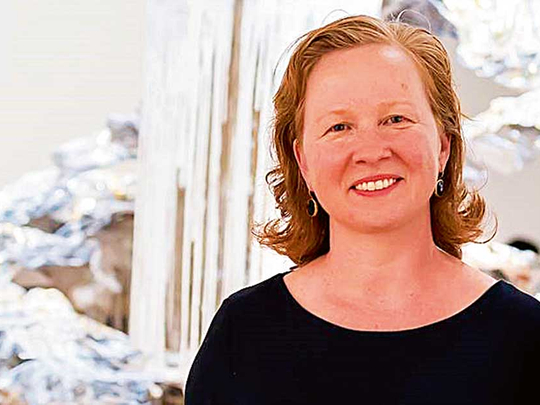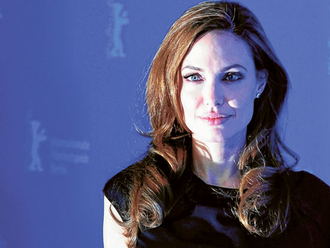
Founding director and chief curator of the NYUAD Art Gallery, Maya Allison had been thinking of organising “But We Cannot See Them: Tracing a UAE Art Community, 1988-2008” show since she moved to Abu Dhabi five years ago.
“When you are doing a historical survey of a group, the approach can be to reproduce a key show from the time, or to show their relationship over time. I decided to do the latter,” she says. Allison spoke to the Weekend Review about her curatorial vision for this show. Excerpts:
Why did you choose this theme for the show?
My specialisation as a curator is on artistic communities and I know how important they are in the development of artists. I have been thinking about this show since I moved to Abu Dhabi five years ago and learned of this community. When I talked to the artists, I realised that core members of this community included not just visual artists but also poets, writers, journalists, musicians, filmmakers and people from the theatre. That became an important part of how we conceptualised the show. We felt that it was important to tell the story through the eyes of the artists and other members, so we did videotaped interviews with them, which are included in the show.
Why did you select the period from 1988 to 2008?
Hassan Sharif was very active prior to this period and the community continued to flourish after 2008. But we decided to start at 1988 because that is when the generation of his students came of age. Their work matured and they began showing regularly and the community formed. It was very active throughout the 1990s and 2000s and by 2007 these artists became established. We stopped at 2008 because The Flying House opened in December 2007, providing a permanent venue for these artists to show their work and for international curators to find them. At the same time, the UAE turned its attention to supporting the cultural sector and announced plans for major museums and art fairs. The few exhibitions in this period included the annual show at the Emirates Fine Arts Society in Sharjah, the Sharjah Biennial, and occasional shows at the Sharjah Art Museum and the French Cultural Centre in Dubai. So, this exhibition is about the two decades when the community, and the ‘sand palace’, were in many ways the art infrastructure for the artists and kept them going in the absence of regular exhibitions.
What was the idea behind the book?
We originally planned a catalogue with some interviews but we later realised that it was crucial to document each member’s story of how they became an artist, the people who influenced them, their memories of the community gatherings and how the members helped each other. We could not interview Hassan Sharif who passed away last year but we have an extensive interview [Cristiana] de Marchi did with him in 2009, that was approved by him but has never been published before. The book also includes an interview Hassan Sharif did with Jos Clevers who passed away in 2009. There is a misunderstanding internationally that contemporary art did not exist in the UAE during that period and this exhibition and book aim to change that notion. The book also includes a seminal essay on the history of Modern art communities in the Gulf region, by art historian Aisha Stoby which contextualises this community as part of many such communities that were forming across the region during this period.
What were the learnings or surprises during your research?
We found that although Hassan Sharif was a very important member and mentor of this community, there were many others who formed the core of the community such as late poet Ahmed Rashid Thani who mentored young poets in the group and helped Ibrahim and Al Saadi. Everybody talks about ‘the five’, but our interviews indicated that Clevers and Vilasini were important members of the community and participated in key shows by the group during that time.
Clevers, who came in 1994 from the Netherlands to teach art, and to look for contemporary artists in the UAE, became a close friend and collaborator of Hassan, and an integral part of the community. He organised one of their first shows in Europe at the Sittard Art Centre in the Netherlands, and came back in 2008 to help set up The Flying House. Hence, we tracked down Vilasini in India, and contacted Clevers’s estate. The most surprising thing for me is that these artists spent 20 years working with no gallery representation, few opportunities to exhibit their work, hardly any sales and no recognition, but they kept going because art mattered to them, and because the community supported this homegrown art scene. They are true artists and I want to do everything I can to help people see that.
Why did you focus on showing works that were originally shown together?
When you are doing a historical survey of a group, the approach can be to reproduce a key show from the time, or to show their relationship over time. I decided to do the latter, but there were key shows, that were watershed moments where different parts of the group came together in especially important exhibitions. We have tried to convey a feeling of what those moments were like by bringing together some works from an important show in 1996 at the Sharjah Art Museum, titled The Six. It featured works by four of ‘the five’, along with Clevers, and it was Vilasini’s first show with the group. It offers a snapshot of the community’s work at that time and although each artist is different, you can see the dialogue between their artworks.
Why did it take so long for these artists to be recognised?
This happens in avant garde communities everywhere in the world. This community was speaking in a very advanced conceptual language about their surroundings and it took people time to appreciate that a pile of cardboard can be beautiful and meaningful when seen through a different lens. These artists had good support from Sharjah to keep them going, total belief in what they were doing, and helped each other to stay committed to their art. They also understood that it was their responsibility to create and educate their audience. Working outside official institutions gave them freedom to be more creative, and made them stronger.












